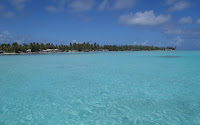 Often called the “Dangerous Archipelago”, the Tuamotus are made up of 78 coral atolls extending almost 1000 miles and known for their variable currents, sudden storms and reefs littered with wrecks. 16,000 people live on 48 of the islands and make a living from copra and black pearls, now only cultured. The area is famous for the nuclear testing France carried out on Mururoa and Fangatauta from 1966 to 1996 during which time 181 nuclear bombs were exploded in the atmosphere and underground. It was a shocking disregard for the pristine environment and local people; the cause of long term and continuing environmental and health problems here.
Often called the “Dangerous Archipelago”, the Tuamotus are made up of 78 coral atolls extending almost 1000 miles and known for their variable currents, sudden storms and reefs littered with wrecks. 16,000 people live on 48 of the islands and make a living from copra and black pearls, now only cultured. The area is famous for the nuclear testing France carried out on Mururoa and Fangatauta from 1966 to 1996 during which time 181 nuclear bombs were exploded in the atmosphere and underground. It was a shocking disregard for the pristine environment and local people; the cause of long term and continuing environmental and health problems here.Spiip sped along on our passage from the Marquesas and we arrived off Kauehi in the dark on Saturday morning and hove to until daylight.
We headed through the Arikitamiro pass bordered by low wooded bands of coral and into the lagoon. Of about 6000 km2 of protected lagoons in the Tuamotus, only 726 km2 is actually land and we could barely see the other side of the atoll 7 miles away. The sun was still too low to make our way safely over to the village so we dropped anchor in 26m of water and decided to snorkel by the pass.
As we each plunged into the water off the dinghy we all let out exclamations of delight at the crystal clear water, colourful coral and multitude of fish. It was without doubt the best snorkelling any of us have seen since the Red Sea. We were struck by the size of the fish – huge groupers everywhere, several Napoleon fish, giant morays, schools of enormous parrot fish; it was like a spectacular aquarium. There were also dozens of sharks of at least 4 different species swimming all around us but fortunately none over 2 metres and for the most part they seemed very uninterested in us.
In the afternoon we anchored by the little village of Tearavero marvelling at the spectacular colours of turquoise water punctuated by ramshackle wooden stilt houses, white sand and green coconut trees. We walked across the narrow spit of land to the windward side to beachcomb, picking up beautiful pieces of coral and cowry shells. The next day we returned to anchor near the pass for the night so that we could enjoy some more snorkelling there before setting off for Fakarava on Sunday morning.

